Chronology of continents
A continent is a large geographical region defined by the continental shelves and the cultures on the continent.[1] In the modern day, there are seven continents. However, there have been more continents throughout history. Vaalbara was the first supercontinent.[2] Europe is the newest continent.[3] Geologists have predicted that certain continents will appear, these being Pangaea Proxima, Novopangaea, Aurica, and Amasia.
List of Continents
| Name | Era | Time before present | Image | Reference |
|---|---|---|---|---|
| Vaalbara | Eoarchean | 3.6-2.7 Ga | _Vaalbara_ancient_continent.png.webp) |
[2] |
| Ur | Paleoarchean | 3.1 Ga | _Eoarchean_Era.png.webp) |
[4] |
| Kenorland | Neoarchean | 2.7 Ga | 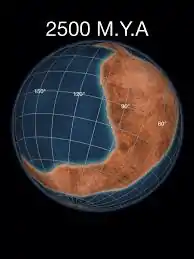 |
[5] |
| Arctica | Neoarchean | 2.565 Ga | 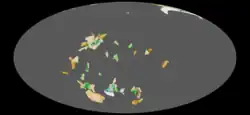 |
[6] |
| Columbia | Paleoproterozoic | 2.1-1.5 Ga |  |
[7] |
| Atlantica | Paleoproterozoic | 2.0 Ga | 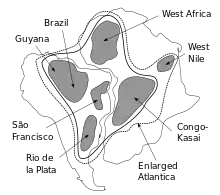 |
[8] |
| Nena | Paleoproterozoic | 1.9 Ga | [9] | |
| Baltica | Paleoproterozoic | 1.8 Ga |  |
[10] |
| Rodinia | Neoproterozoic | 1100-633 Ma |  |
[11] |
| Avalonia | Neoproterozoic | 750 Ma |  |
[12] |
| Pannotia | Neoproterozoic | 500-600 Ma | 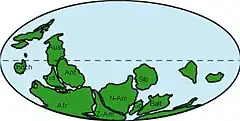 |
[13] |
| Pampia | Neoproterozoic | 555-515 Ma | [11] | |
| Gondwana | Neoproterozoic | 550 Ma |  |
[14] |
| Cimmeria | Neoproterozoic | 550 Ma |  |
[15] |
| Laurasia | Neoproterozoic | 550 Ma | 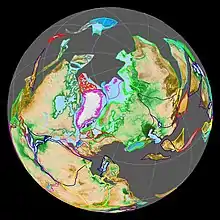 |
[16] |
| Cuyania | Paleozoic | ~420-390 Ma | [17] | |
| Chilenia | Paleozoic | ~420-390 Ma | [18] | |
| Pangaea | Paleozoic | 335 Ma |  |
[16] |
| Africa | Paleozoic | 300 Ma | .svg.png.webp) |
[19] |
| South America | Mesozoic | 225 Ma | .svg.png.webp) |
[20] |
| North America | Mesozoic | 200 Ma | .png.webp) |
[21] |
| Mauritia | Mesozoic | 70-60 Ma | 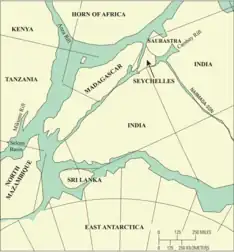 |
[22] |
| Asia | Mesozoic | 66 Ma | .svg.png.webp) |
[23] |
| Australia | Cenozoic | 10 Ma | 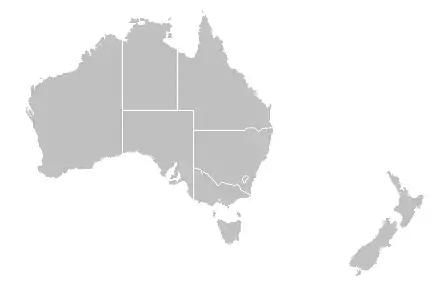 |
[24] |
| Europe | Cenozoic | 5 Ma |  |
[25] |
| Pangaea Proxima | ~250 myf | 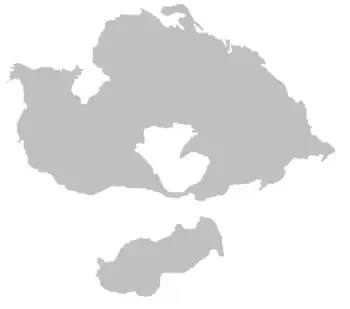 |
[3] | |
| Novopangaea | ~250 myf | .jpg.webp) |
[26] | |
| Aurica | ~250 myf | [26] | ||
| Amasia | ~250 myf | 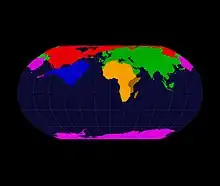 |
[26] |
References
- "Continent". National Geographic Society. 2011-09-20. Archived from the original on 2021-03-03. Retrieved 2021-02-01.
- Zegers, T. E.; de Wit, M. J.; White, S. H. (1998). "Vaalbara, Earth's oldest assembled continent? A combined. structural, geochronological, and palaeomagnetic test" (PDF). Terra Nova. 10(5): 250–259.
- Willams, Caroline; Nield, Ted (2007). "Earth's next supercontinent". New Scientist. 196 (2626): 36–40. doi:10.1016/S0262-4079(07)62661-X.
- Rogers & Santosh 2003, Rodinia, pp. 363–364
- Pesonen, L. J.; Elming, S.-Å.; Mertanen, S.; Pisarevsky, S.; D’Agrella-Filho, M. S.; Meert, J. G.; Schmidt, P. W.; Abrahamsen, N.; Bylund, G. (2003). "Palaeomagnetic configuration of continents during the Proterozoic". Tectonophysics. 375 (1–4): 289–324
- Vernikovsky, V. A.; Dobretsov, N. L. (2015). "Geodynamic evolution of the Arctic Ocean and modern problems in geological studies of the Arctic region". Herald of the Russian Academy of Sciences. 85 (3): 206–212.
- Zhao, G.; Cawood, P. A.; Wilde, S. A.; Sun, M. (2002). "Review of global 2.1–1.8 Ga orogens: implications for a pre-Rodinia supercontinent". Earth-Science Reviews. 59 (1): 125–162.
- Rogers, John J. W. (1996). "A History of Continents in the past Three Billion Years". The Journal of Geology. 104 (1): 91–107. Bibcode:1996JG....104...91R. doi:10.1086/629803. ISSN 0022-1376. S2CID 128776432. Archived from the original on 2021-03-03. Retrieved 2021-02-01.
- Gower, Ryan & Rivers 1990, Introduction, p. 2
- Cocks, L. R. M.; Torsvik, T. H. (2005). "Baltica from the late Precambrian to mid-Palaeozoic times: the gain and loss of a terrane's identity" (PDF). Earth-Science Reviews. 72 (1–2): 39–66.
- Gaucher, Claudio; Bossi, Jorge; Blanco, Gonzalo (2009). "Palaeogeography". Neoproterozoic-Cambrian Tectonics, Global Change and Evolution: A Focus on South Western Gondwana. Developments in Precambrian Geology. 16. pp. 131–41. doi:10.1016/S0166-2635(09)01609-0. ISBN 978-0-444-53249-7.
- Murphy, J. B.; Pisarevsky, S. A.; Nance, R. D.; Keppie, J. D. (2001). Jessell, M. J. (ed.). "Animated history of Avalonia in Neoproterozoic - Early Proterozoic". General Contributions. Journal of the Virtual Explorer. 3: 45–58. doi:10.3809/jvirtex.2001.00026. Retrieved 28 November 2015.
- Scotese 2009, Reconstruction of Rodinia and Pannotia, p. 68
- Bradley, D.C. (2011). "Secular Trends in the Geologic Record and the Supercontinent Cycle". Earth-Science Reviews. 108 (1–2): 16–33. CiteSeerX 10.1.1.715.6618. doi:10.1016/j.earscirev.2011.05.003.
- Buchs, D. M.; Bagheri, S.; Martin, L.; Hermann, J.; Arculus, R. (2013). "Paleozoic to Triassic ocean opening and closure preserved in Central Iran: Constraints from the geochemistry of meta-igneous rocks of the Anarak area". Lithos. 172: 267–287.
- Blakey 2003, Assembly of Western Pangaea: Carboniferous–Permian, pp. 453–454; Assembly of Eastern Pangaea: Late Permian–Jurassic, p. 454; Fig. 10, p. 454
- Rapalini 2005
- Rapalini, A.E. 2005. The accretionary history of southern South America from the latest Proterozoic to the Late Palaeozoic: some palaeomagnetic constraints. From: Vaughan, A. R M., Leat, P. T. & Pankhurst, R. J, (eds). Terrane Processes at the Margins of Gondwana. Geological Society, London, Special Publications, 246, 305-328.
- "Africa - Geologic history". Encyclopedia Britannica. Archived from the original on 2021-01-25. Retrieved 2021-02-01.
- "South America - Geologic history". Encyclopedia Britannica. Archived from the original on 2020-05-07. Retrieved 2021-02-04.
- "North America - Tectonic evolution". Encyclopedia Britannica. Archived from the original on 2015-05-03. Retrieved 2021-02-01.
- Torsvik, Trond H.; Amundsen, Hans; Hartz, Ebbe H.; Corfu, Fernando; Kusznir, Nick; Gaina, Carmen; Doubrovine, Pavel V.; Steinberger, Bernhard; Ashwal, Lewis D.; Jamtveit, Bjørn (24 February 2013). "A Precambrian microcontinent in the Indian Ocean" (PDF). Nature Geoscience. 6 (3): 223–227. doi:10.1038/ngeo1736. hdl:10852/62002. ISSN 1752-0894. Retrieved 5 December 2015.
- "Asia - Geologic history". Encyclopedia Britannica. Archived from the original on 2008-11-18. Retrieved 2021-02-01.
- "Australia - Geologic history". Encyclopedia Britannica. Archived from the original on 2015-05-02. Retrieved 2021-02-01.
- "Europe - Geologic history". Encyclopedia Britannica. Archived from the original on 2014-12-12. Retrieved 2021-02-01.
- Wilkins, Alasdair. "A Geological History of Supercontinents on Planet Earth" at io9. 27 Jan 2011. Accessed 22 July 2014.
This article is issued from Wikipedia. The text is licensed under Creative Commons - Attribution - Sharealike. Additional terms may apply for the media files.